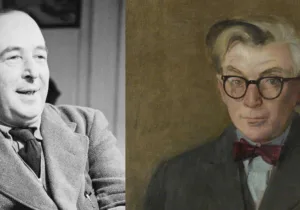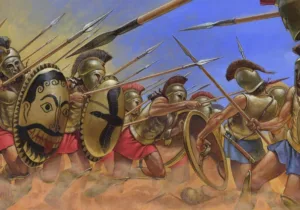On November 22 in Washington, DC, Daniel Dreisbach of American University spoke about the legacy of the Pilgrims.
The Pilgrims, who came ashore at Plymouth Rock in 1620, followed by their theological cousins the Puritans, who established Massachusetts Bay in 1630, were not the first Europeans, not even the first Englishmen, to settle in North America. Yet they, more than any others, defined an American national identity and laid the foundations for an American political tradition committed to the rule of law and constitutionalism.
The Pilgrims were religious dissenters – theological separatists – who reluctantly concluded that the Protestant Church of England from which they separated themselves was irredeemably corrupt. They were a profoundly religious people who had experienced oppression in England at the hands of authorities in church and state, and they crossed the Atlantic Ocean to escape religious persecution in the Old World and to seek religious liberty in the New World.
They, like their Puritan cousins who followed them, were on a mission to establish a Bible commonwealth grounded on biblical principles and laws as they understood them. They wanted to create a political community devoted to their God and committed to the rule of law. Their experiment in political self-government birthed a constitutional tradition that blended biblical law interpreted through the lens of their Reformed theology with English common law adapted to the needs of their community. Key features of that tradition persist to the present day.
“The First Foundation of their Government”
The Pilgrims’ condemnation of the established Church of England won them few friends in positions of power and influence in England. In fact, English authorities harassed them, fined them, and even threw them in jail. Their religious beliefs counseled that fleeing the persecution was preferable to fighting back against those who persecuted them. In 1608, members of their religious community went into exile in the Netherlands to escape oppression in their homeland. After a decade or so in the Netherlands, the Pilgrims began to hear about opportunities in North America. And so a small group decided to leave Europe for America, arriving in New England in November 1620.
Before leaving Europe, they made arrangements with the Virginia Company to settle in Virginia, but their tiny ship, the Mayflower, was blown off course by fierce storms crossing the North Atlantic, and they made landfall off Cape Cod to the north of their intended destination. A little over 100 passengers were on board their little ship, divided between Pilgrims and non-Pilgrims (that is, Separatists and Strangers, respectively, as they were sometimes called). In addition, there was a crew of about 30 men.
Their arrival in New England raised the thorny political question whether they were subject to English authority, specifically the Virginia Company, as they would have been had they arrived in Virginia as planned. William Bradford, a Pilgrim leader who would serve as Plymouth colony’s second governor, reported that there were “discontented and mutinous” murmurings among the non-Pilgrims aboard ship that their agreement with the Virginia Company was void, and they were at liberty to do as they willed.[1] To remove doubts about the governing authority in their community, both the Pilgrim and non-Pilgrim adult passengers aboard the Mayflower entered into a social compact with each other, with God as their witness, as they prepared to come ashore in New England.
This agreement, which was designed to nurture unity among the settlers and facilitate a future civil government, has come to be known as the Plymouth Combination or, more famously, the Mayflower Compact.[2] It was signed aboard the Mayflower on November 11, 1620.[3] How did the outside world learn of this Compact agreed to by a small, obscure company of settlers clinging to the New England coast? The original, signed copy has, apparently, been lost. The text, however, was published and sold in London in 1622, barely a year after it was signed. It was included in a very early history of the settlement, parts of which appear to have been written by Edward Winslow and William Bradford. The work was entitled A Relation or Journall of the beginning and proceedings of the English Plantation settled at Plimoth in New England and known popularly as Mourt’s Relation — a reference, perhaps, to George Morton, a Separatist who had remained in Europe and conducted business on behalf of the settlers.[4] The Compact was more famously reproduced in William Bradford’s journal chronicling the Pilgrims’ experiences in both Europe and New England, which was not published until the nineteenth century.[5] Nathaniel Morton, the son of George Morton, a Separatist settler at Plymouth and the colony’s secretary and longtime historian (from 1645 until his death in 1685), included the Compact (along with, for the first time, the names of the signatories) in his New England’s Memorial, published in Cambridge, Massachusetts in 1669.[6] From these sources, starting in 1622, the Compact was brought to the attention of a wide audience and entered English and American political and legal discourse.[7]
In the tradition of Old Testament covenants between God and His people, the agreement was made, the Pilgrims believed, “in the presence of God.” Emphasizing the document’s sacred character, it began with an invocation: “In the Name of God, Amen.” This language underscored the signatories’ obligations to and reliance on God and erased any doubt that the makers believed their compact was in the tradition of religious covenants. This agreement in its totality was essentially an oath subscribed to by the signatories, affirming the existence of a political community with attendant political obligations secured by that oath.
Remarkably, at a moment when the Pilgrims could have considered declaring their independence from English authorities, which might have been expected given their unhappy experiences in England, they instead made a covenant – a constitution of sorts – acknowledging their obligations to God and to king and country. They were not a lawless or anarchic people.[8] To the contrary, their agreement in November 1620 demonstrated a commitment to the rule of law and constitutionalism. William Bradford described the Compact in his journal as “the first foundation of their government in this place.”[9]
What is a Constitution?
A constitution is a political community’s expression of its fundamental, authoritative law, setting out the basic principles, substantive components, and procedural rules by which government power is to be legitimately exercised.
Scholars debate whether or not the Compact is a fully formed constitution; it is at least a proto-constitution – or the seed of a constitution – committing its signatories to create, in the Compact’s words, a “civil Body Politick” and to frame, enact, and obey “such just and equal Laws, Ordinances, Acts, Constitutions, and Offices” deemed necessary for the common good. The very act and the manner of framing this agreement affirmed civil government based on the consent and participation of the governed, among the most cherished of American political ideals. This was to be government by the consent of self-governing citizens equal before God, each other, and the law. Both high and low, governor and governed, Pilgrim and non-Pilgrim were to be answerable to the same law. This principle of legal equality is a fundamental tenet of the “rule of law.”
There is no consensus among historians and political commentators about how to view the Mayflower Compact and its significance as a legal or political document. Some have described it as the foundation of an American experiment in democratic governance; others have dismissed it as a document of little or no consequence. In Bradford’s account, it was an instrument designed to hold factions together as the settlers prepared to come ashore and build a new political society. Others have suggested that it was calculated to give Separatists a political advantage over potential rivals among the Strangers. There is a case to be made that the Compact is the oldest surviving political agreement in the modern world asserting rule by popular consent.[10] For this reason alone, the making of the Compact is a signal event in the development of an American constitutional tradition. Although a remarkably brief document (less than 200 words), in its simple structure and form is a pattern evident in almost all subsequent American constitutions, including the national Constitution written in Philadelphia in the summer of 1787, which remains “the supreme Law of the Land.”
A Constitutional Template
The Mayflower Compact, I contend, is important not because it was profoundly innovative in content; indeed, its framers almost certainly drew on earlier agreements and traditions. Rather, it is important because it is a link in the chain reaching back to Old World civil and ecclesiastical constitutional traditions and connecting them to what would become an American constitutional tradition — a tradition that would produce the national Constitution of 1787 and virtually every American constitution in between and since. Moreover, it is a constitution or constitution-like document written early in the colonial experience that is an exemplar of the design and content of almost every constitution framed in America in the centuries that followed and continuing to the present day.
In their book The Basic Symbols of the American Political Tradition (1970), Willmoore Kendall and George W. Carey argued that the Mayflower Compact set a template for written constitutions.[11] Although not original to the Compact in all its parts – elements resemble and arguably drew on earlier constitutions and constitution-like documents in church and state – the same basic structure would be used by subsequent constitutional framers in North America.
This constitutional template begins, appropriately, with a clear identification of those for whom the document was created. This act of identification is found in the Compact’s second sentence: “We whose Names are underwritten.” A similar statement of identity is expressed in the U.S. Constitution’s opening immortal phrase: “We the People.” It should not be overlooked that the Compact further identifies the framers as “the loyal subjects of our dread Sovereign Lord King James . . . of Great Britain, France, and Ireland,” confirming, it would seem, that the signers were not lawless rebels.
This language of self-identification, more significantly, is also language of self-definition. A phrase like “we the people” in a foundational document confirms for the framers and announces to the world the creation of a new people – a new political community – out of formerly disparate peoples. The Saints and the Strangers – the Pilgrims and the non-Pilgrims – aboard the Mayflower used this clause of self-identification to describe themselves united in political purpose. They consciously constituted themselves as a people knitted or “combine[d]” together (in the Compact’s words) for the purpose of governance in the service of the common good.[12]
This is followed by a statement of the purposes for their political society: “for the glory of God, and advancement of the Christian Faith, and the Honour of our King and Country.”[13] A corresponding statement of purposes for the national charter of 1787 is found in the noble aspirations of the Preamble:
in Order to form a more perfect Union, establish Justice, insure domestic Tranquility, provide for the common defence, promote the general Welfare, and secure the Blessings of Liberty to ourselves and our Posterity…
The framers of and signatories to the Mayflower Compact then entered into a solemn covenant to create a “civil Body Politick” and the attendant “just and equal Laws, Ordinances, Acts, Constitutions, and Offices . . . thought most meet and convenient for the general good of the Colony.” Equivalent language in the U.S. Constitution reads: “We . . . do ordain and establish this Constitution for the United States of America,” which is then followed by six articles defining the structures, institutions, offices, and the processes of the new constitutional regime. What’s missing from the Compact, that one might expect in a fully formed constitution, are the specific nuts and bolts of governance. This was left to be worked out in the future; and, indeed, the institutions, structures, and offices of a “civil Body Politick” would be developed in the colony’s subsequent acts, agreements, and ordinances.[14] (The absence of these specific nuts and bolts of governance is why some constitutional scholars describe the Mayflower Compact as something less than a fully formed constitution.)
Finally, in identical language – “In witness whereof we have hereunto subscribed our Names” – both the Mayflower Compact and the U.S. Constitution conclude with the framers’ signatures indicating their pledge of mutual commitment and obligation to each other and to the common good. Also, both documents are dated with reference to the birth of Jesus Christ.
Thus, the framers of the Mayflower Compact made use of an outline and a form that future American constitutional framers would also use. Once again, this template begins with (1) the identification of those for whom the constitution was framed, and it includes (2) a statement of purposes and aspirations for their political society, followed by (3) the creation of a “civil body politic,” and then concludes with (4) a pledge of mutual commitment and obligation, affirmed by signatures. More generally, the Compact is a noteworthy expression of a commitment to the rule of law, legal equality, and civil government by the consent and participation of the governed.
* * * * * *
The U.S. Constitution of 1787 is a product of a constitutional tradition that was, in significant respects, informed by New England’s Bible commonwealths and includes many features in design and content that would have been familiar to New England’s Bible-reading people.[15] The national Constitution and the constitutional tradition from which it emerged are, in part, a legacy of a seminal project in political self-government and liberty under law that began off New England’s rocky coasts in November 1620 and flourished in the years that followed.
APPENDIX
The Plymouth Combination, or The Mayflower Compact
IN THE NAME OF GOD, AMEN. We, whose names are underwritten, the Loyal Subjects of our dread Sovereign Lord King James, by the Grace of God, of Great Britain, France, and Ireland, King, Defender of the Faith, &c. Having undertaken, for the Glory of God, and Advancement of the Christian Faith, and the Honour of our King and Country, a Voyage to plant the first Colony in the northern Parts of Virginia; Do by these Presents, solemnly and mutually, in the Presence of God and one another, covenant and combine ourselves together into a civil Body Politick, for our better Ordering and Preservation, and Furtherance of the Ends aforesaid: And by Virtue hereof do enact, constitute, and frame, such just and equal Laws, Ordinances, Acts, Constitutions, and Offices, from time to time, as shall be thought most meet and convenient for the general Good of the Colony; unto which we promise all due Submission and Obedience. IN WITNESS whereof we have hereunto subscribed our names at Cape-Cod the eleventh of November, in the year of the Reign of our Sovereign Lord King James, of England, France, and Ireland, the eighteenth, and of Scotland the fifty-fourth. Anno Domini 1620.
[Signatures]
[1] William Bradford, Of Plymouth Plantation, 1620—1647, ed. Samuel Eliot Morison (New York: Alfred A. Knopf, 1953), 75.
[2] The Plymouth Combination, or The Mayflower Compact (November 11, 1620), reprinted inColonial Origins of the American Constitution: A Documentary History, ed. Donald S. Lutz (Indianapolis: Liberty Fund, 1998), 32.
[3] The Mayflower Compact was signed on November 11, 1620 (Old Style, Julian calendar); November 21, 1619 (New Style, Gregorian calendar).
[4] A Relation or Journall of the beginning and proceedings of the English Plantation settled at Plimoth in New England (London: printed by J. Dawson for Iohn Bellamie, 1622), 3.
[5] This work is widely known as Of Plymouth Plantation. The Mayflower Compact is reproduced in Bradford, Of Plymouth Plantation, 75-76.
[6] Nathaniel Morton, New-englands memoriall, or, A brief relation of the most memorable and remarkable passages of the providence of god manifested to the planters of new-england in america with special reference to the first colony thereof, called new-plimouth [New England’s Memorial] (Cambridge, Mass.: printed by S.G. and M.J. for John Vsher of Boston, 1669), 14-16.
[7] It should also be noted that the existence and authority of the Plymouth Combination were recognized in subsequent laws of Plymouth colony. See, for example, “Pilgrim Code of Law” (November 15, 1636), in Lutz, Colonial Origins, 62.
[8] In a parting admonition to the Pilgrims written in the summer of 1620, their pastor in the Netherlands, The Reverend John Robinson, wrote: “whereas you are become a body politic, using amongst yourselves civil government, and are not furnished with any persons of special eminency above the rest, to be chosen by you into office of government; let your wisdom and godliness appear, not only in choosing such persons as do entirely love and will promote the common good, but also in yielding unto them all due honour and obedience in their lawful administrations, not beholding in them the ordinariness of their persons, but God’s ordinance for your good; not being like the foolish multitude who more honour the gay coat than either the virtuous mind of the man, or glorious ordinance of the Lord. But you know better things, and that the image of the Lord’s power and authority which the magistrate beareth, is honourable, in how mean persons soever. And this duty you both may the more willingly and ought the more conscionably to perform, because you are at least for the present to have only them for your ordinary governors, which yourselves shall make choice of for that work.” The Rev. John Robinson’s Farewell Letters to John Carver, July 1620, reprinted in Bradford, Of Plymouth Plantation, 370. Scholars have long speculated that this paragraph inspired the framing of the Mayflower Compact. See ibid., 370 n. 6.
[9] Bradford, Of Plymouth Plantation, 75.
[10] Lutz, Colonial Origins, 31 (“The Mayflower Compact is the oldest surviving compact based on popular consent.”).
[11] Willmoore Kendall and George W. Carey, The Basic Symbols of the American Political Tradition (Baton Rouge: Louisiana State University Press, 1970), 30-42.
[12] See Lutz, Introductory Essay, in Colonial Origins, xxiv.
[13] In Of Plymouth Plantation, Bradford recounted that the Pilgrims were moved to leave for the New World, in part, by “a great hope and inward zeal they had of laying some good foundation, or at least to make some way hereunto, for the propagating and advancing the gospel of the kingdom of Christ in those remote parts of the world; yea, though they should be but even as stepping-stones unto others for the performing of so great a work.” Bradford, Of Plymouth Plantation, 25.
[14] See, for example, “Pilgrim Code of Law” (November 15, 1636), in Lutz, Colonial Origins, 61-67.
[15] See Daniel L. Dreisbach, “Christianity and American Law,” in Great Christian Jurists in American History, ed. Daniel L. Dreisbach and Mark David Hall, 1-15 (Cambridge and New York: Cambridge University Press, 2019) and Daniel L. Dreisbach, “Does Biblical Literacy Enrich Constitutional Literacy?: The Bible’s Forgotten Influence on the American Constitutional Tradition,” Canopy Forum, September 23, 2020.







 Sponsor a student for Christianity & National Security 2024
Sponsor a student for Christianity & National Security 2024